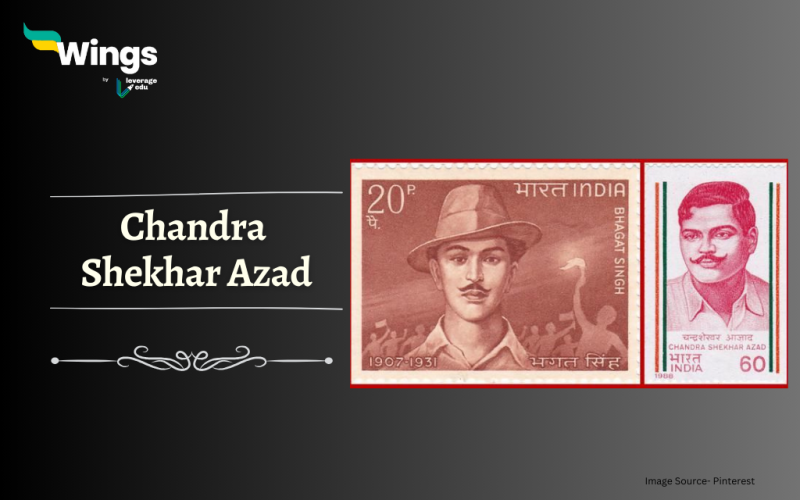Chandra Shekhar Tiwari was a freedom fighter who was best known by the stage name Chandrashekhar Azad. After the passing of the HRA’s founder, Ram Prasad Bismil, Rajendra Nath Lahiri, Roshan Singh, and Ashfaqulla Khan, he reorganised the HRA under the new name, Hindustan Socialist Republican Association (HSRA). As the head of the HSRA, he frequently signed pamphlets under the nickname “Balraj”. In this blog, we will learn more about this freedom fighter and his life.
Table of Contents [show]
Chandra Shekhar Azad’s History of His Early Life, Family and Education
- The date of Chandrashekhar Azad’s birth is July 23, 1906.
- The modern Madhya Pradesh region of Alirajpur is where Chandrasekhar Azad was born.
- He went by Chandra Shekhar Tiwari in real life.
- Jagrani Devi and Sitaram Tiwari were the names of Chandrasekhar Azad’s parents.
- At Bhavra, he acquired his early education.
- Later, he moved to Banaras to attend Kashi Vidyapeeth for further studies.
- Chandrasekhar Azad got interested in revolutionary movements at an early age. He joined the Mahatma Gandhi-led non-cooperation movement in 1921 and voiced his opposition to the Jallianwala Bagh massacre.
- When he was seized by British soldiers at the age of 15, he was put behind bars for the first time and given a 15-lash sentence.
- He adopted the surname Azad and changed his name to Chandrashekhar Azad as a result of this episode.
Also Read – 20+ Greatest Indian Freedom Fighters and their Sacrifices
What were the revolutionary activities of Chandrashekhar Azad?
There were many revolutionary activities in which Azad actively participated. Some of his revolutions are –
1. The Kakori Train Robbery: One of the most audacious acts of defiance committed by Azad and his fellow revolutionaries was the Kakori train robbery on August 9, 1925. They targeted a train carrying British government funds near Kakori in present-day Uttar Pradesh. This daring act shocked the British authorities and garnered immense support for the revolutionaries.
To avoid capture and continue his mission, Chandra Shekhar Azad adopted the pseudonym “Azad,” meaning “Free.” His commitment to the cause and his fearless nature earned him the title of the “Avenging Angel” amongst the British officials, who feared his every move.
Also Read – Swadeshi Movement: Leaders, Timeline, History
2. The Lahore Conspiracy Case: In 1929, Chandra Shekhar Azad, along with Bhagat Singh, Sukhdev Thapar, and others, plotted to avenge the death of Lala Lajpat Rai. However, they mistakenly killed British police officer John Saunders instead. The police launched a massive manhunt, ultimately resulting in Azad’s arrest.

During the infamous Lahore Conspiracy Case, Chandra Shekhar Azad displayed extreme courage and resilience. Despite brutal interrogation and the impending threat of execution, he refused to disclose any information about his comrades or the revolutionaries’ plans.
Also Read – Azad Hind Fauj: Background, Founder, Decline
Chandra Shekhar Azad Death
- Chandra Shekhar Azad shot himself to death at Alfred Park, now infamously known as Azad Park in Allahabad, on February 27, 1931, while he was being encircled by police and had run out of ammunition.
- The police encircled him after Veerbhadra Tiwari, their former friend who suddenly turned traitor, informed them of his location in the park.
- Sukhdev Raj wounded himself while acting in self-defence, killing three police officers and injuring others. As a result of his acts, Sukhdev Raj was able to escape.
- The body was brought to Rasulabad Ghat to perform cremation without informing the general population. As soon as word spread, a crowd gathered in the park where the incident had place. They shouted obscenities at the British and thanked Azad.
Relevant Blogs
| Lord Lansdowne | Lord Irwin |
| Lord Lytton | Lord Chelmsford |
| The Government of India Act 1919 | Kiran Bedi |
| Morley-Minto Reforms | Gandhi Irwin Pact (1931) |
| Bengal Partition | Birsa Munda |
This was all about the freedom fighter Chandra Shekhar Azad. If you want to read more articles like this, you can get Short notes on the Modern History of India here. Also, you can visit our general knowledge page on Indian History!
 One app for all your study abroad needs
One app for all your study abroad needs















 45,000+ students trusted us with their dreams. Take the first step today!
45,000+ students trusted us with their dreams. Take the first step today!
